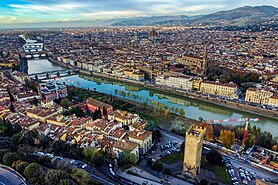Florence
Florence
Firenze (Italian) | ||
|---|---|---|
| Comune di Firenze | ||
|
| ||
ISTAT code 048017 | | |
| Patron saint | John the Baptist[3] | |
| Saint day | 24 June | |
| Website | Official website | |
Florence (/ˈflɒrəns/ FLORR-ənss; Italian: Firenze [fiˈrɛntse] ⓘ)[a] is the capital city of the Italian region of Tuscany. It is also the most populated city in Tuscany, with 360,930 inhabitants in 2023, and 984,991 in its metropolitan area.[4]
Florence was a centre of medieval European trade and finance and one of the wealthiest cities of that era.[5] It is considered by many academics[6] to have been the birthplace of the Renaissance, becoming a major artistic, cultural, commercial, political, economic and financial center.[7] During this time, Florence rose to a position of enormous influence in Italy, Europe, and beyond.[8] Its turbulent political history includes periods of rule by the powerful Medici family and numerous religious and republican revolutions.[9] From 1865 to 1871 the city served as the capital of the Kingdom of Italy. The Florentine dialect forms the base of standard Italian and it became the language of culture throughout Italy[10] due to the prestige of the masterpieces by Dante Alighieri, Petrarch, Giovanni Boccaccio, Niccolò Machiavelli and Francesco Guicciardini.
The city attracts millions of tourists each year, and UNESCO declared the Historic Centre of Florence a World Heritage Site in 1982. The city is noted for its culture, Renaissance art and architecture and monuments.[11] The city also contains numerous museums and art galleries, such as the Uffizi Gallery and the Palazzo Pitti, and still exerts an influence in the fields of art, culture and politics.[12] Due to Florence's artistic and architectural heritage, Forbes ranked it as one of the most beautiful cities in the world in 2010.[13]
Florence plays an important role in Italian fashion,[12] and is ranked in the top 15 fashion capitals of the world by Global Language Monitor;[14] furthermore, it is a major national economic centre,[12] as well as a tourist and industrial hub.
Etymology
Firenze comes from Florentiae,
History
Historical affiliations
Roman Republic, 59–27 BC
Roman Empire, 27 BC–AD 285
Western Roman Empire, 285–476
Kingdom of Odoacer, 476–493
Ostrogothic Kingdom, 493–553
Eastern Roman Empire, 553–568
Lombard Kingdom, 570–773
Carolingian Empire, 774–797
Regnum Italiae, 797–1001
March of Tuscany, 1002–1115
Republic of Florence, 1115–1532
Duchy of Florence, 1532–1569
Grand Duchy of Tuscany, 1569–1801
Kingdom of Etruria, 1801–1807
First French Empire, 1807–1815
Grand Duchy of Tuscany, 1815–1859
United Provinces of Central Italy, 1859–1860
Kingdom of Italy, 1861–1943
Italian Social Republic, 1943–1945
Italy, 1946–present
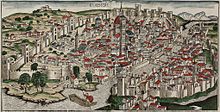
Florence originated as a Roman city, and later, after a long period as a flourishing trading and banking medieval commune, it was the birthplace of the Italian Renaissance. It was politically, economically, and culturally one of the most important cities in Europe and the world from the 14th to 16th centuries.[11]
The language spoken in the city during the 14th century came to be accepted as the model for what would become the Italian language. Thanks especially to the works of the Tuscans Dante, Petrarch and Boccaccio,[16] the Florentine dialect, above all the local dialects, was adopted as the basis for a national literary language.[17][18]
Starting from the late
Florence was home to the Medici, one of European history's most important noble families.
The Kingdom of Italy, which was established in 1861, moved its capital from Turin to Florence in 1865, although the capital was moved to Rome in 1871.
Roman origins
Florence was established by the Romans in 59 BC as a colony for veteran soldiers and was built in the style of an army camp.[19] Situated along the Via Cassia, the main route between Rome and the north, and within the fertile valley of the Arno, the settlement quickly became an important commercial centre and in AD 285 became the capital of the Tuscia region.
Early Middle Ages
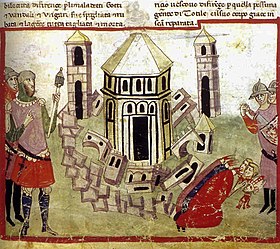
In centuries to come, the city experienced turbulent alternate periods of Ostrogoth and Byzantine rule, during which the city was fought over, helping to cause the population to fall to as low as 1,000 people.[20] Peace returned under Lombard rule in the 6th century and Florence was in turn conquered by Charlemagne in 774 becoming part of the March of Tuscany centred on Lucca. The population began to grow again and commerce prospered.
Second millennium

Middle Ages and Renaissance
Rise of the Medici
At the height of demographic expansion around 1325, the urban population may have been as great as 120,000, and the rural population around the city was probably close to 300,000.
In the 15th century, Florence was among the largest cities in Europe, with a population of 60,000, and was considered rich and economically successful.[27] Cosimo de' Medici was the first Medici family member to essentially control the city from behind the scenes. Although the city was technically a democracy of sorts, his power came from a vast patronage network along with his alliance to the new immigrants, the gente nuova (new people). The fact that the Medici were bankers to the pope also contributed to their ascendancy. Cosimo was succeeded by his son Piero, who was, soon after, succeeded by Cosimo's grandson, Lorenzo in 1469. Lorenzo was a great patron of the arts, commissioning works by Michelangelo, Leonardo da Vinci and Botticelli. Lorenzo was an accomplished poet and musician and brought composers and singers to Florence, including Alexander Agricola, Johannes Ghiselin, and Heinrich Isaac. By contemporary Florentines (and since), he was known as "Lorenzo the Magnificent" (Lorenzo il Magnifico).
Following Lorenzo de' Medici's death in 1492, he was succeeded by his son
Savonarola, Machiavelli, and the Medici popes
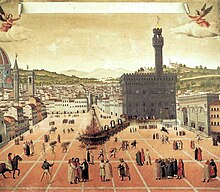
During this period, the Dominican friar Girolamo Savonarola had become prior of the San Marco monastery in 1490. He was famed for his penitential sermons, lambasting what he viewed as widespread immorality and attachment to material riches. He praised the exile of the Medici as the work of God, punishing them for their decadence. He seized the opportunity to carry through political reforms leading to a more democratic rule. But when Savonarola publicly accused Pope Alexander VI of corruption, he was banned from speaking in public. When he broke this ban, he was excommunicated. The Florentines, tired of his teachings, turned against him and arrested him. He was convicted as a heretic, hanged and burned on the Piazza della Signoria on 23 May 1498. His ashes were dispersed in the Arno river.[28]
Another Florentine of this period was Niccolò Machiavelli, whose prescriptions for Florence's regeneration under strong leadership have often been seen as a legitimization of political expediency and even malpractice. Machiavelli was a political thinker, renowned for his political handbook The Prince, which is about ruling and exercising power. Commissioned by the Medici, Machiavelli also wrote the Florentine Histories, the history of the city.
In 1512, the Medici retook control of Florence with the help of Spanish and Papal troops.
Florence officially became a monarchy in 1531, when Emperor Charles and Pope Clement named
18th and 19th centuries
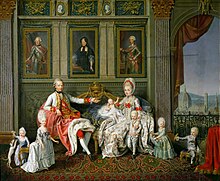
The extinction of the Medici dynasty and the accession in 1737 of
Florence replaced
The country's second capital city was superseded by Rome six years later, after the withdrawal of the French troops allowed the capture of Rome.
20th century

During

Florence was liberated by
At the end of World War II in May 1945, the US Army's Information and Educational Branch was ordered to establish an overseas university campus for demobilised American service men and women in Florence. The first American university for service personnel was established in June 1945 at the School of Aeronautics. Some 7,500 soldier-students were to pass through the university during its four one-month sessions (see
In November 1966, the
Geography

Florence lies in a basin formed by the hills of
Climate
Florence has a
| Climate data for Florence (Florence Airport, 1991–2020 normals) | |||||||||||||
|---|---|---|---|---|---|---|---|---|---|---|---|---|---|
| Month | Jan | Feb | Mar | Apr | May | Jun | Jul | Aug | Sep | Oct | Nov | Dec | Year |
| Record high °C (°F) | 21.6 (70.9) |
23.4 (74.1) |
28.5 (83.3) |
28.7 (83.7) |
33.8 (92.8) |
41.8 (107.2) |
42.6 (108.7) |
39.5 (103.1) |
36.4 (97.5) |
30.8 (87.4) |
25.2 (77.4) |
20.4 (68.7) |
42.6 (108.7) |
| Mean daily maximum °C (°F) | 10.9 (51.6) |
12.7 (54.9) |
16.8 (62.2) |
20.2 (68.4) |
24.5 (76.1) |
28.9 (84.0) |
31.8 (89.2) |
32.1 (89.8) |
27.0 (80.6) |
21.8 (71.2) |
16.2 (61.2) |
12.2 (54.0) |
21.3 (70.3) |
| Daily mean °C (°F) | 6.5 (43.7) |
7.7 (45.9) |
11.1 (52.0) |
14.2 (57.6) |
18.4 (65.1) |
22.5 (72.5) |
25.2 (77.4) |
25.4 (77.7) |
21.0 (69.8) |
16.5 (61.7) |
11.5 (52.7) |
7.5 (45.5) |
15.6 (60.1) |
| Mean daily minimum °C (°F) | 2.2 (36.0) |
2.6 (36.7) |
5.4 (41.7) |
8.1 (46.6) |
12.3 (54.1) |
16.2 (61.2) |
18.5 (65.3) |
18.7 (65.7) |
15.0 (59.0) |
11.2 (52.2) |
6.8 (44.2) |
2.8 (37.0) |
10.0 (50.0) |
| Record low °C (°F) | −23.2 (−9.8) |
−9.9 (14.2) |
−8.0 (17.6) |
−2.2 (28.0) |
3.6 (38.5) |
5.6 (42.1) |
10.2 (50.4) |
9.6 (49.3) |
3.6 (38.5) |
−1.4 (29.5) |
−6.0 (21.2) |
−8.6 (16.5) |
−23.2 (−9.8) |
| Average precipitation mm (inches) | 60.5 (2.38) |
63.7 (2.51) |
63.5 (2.50) |
86.4 (3.40) |
70.0 (2.76) |
57.1 (2.25) |
36.7 (1.44) |
56.0 (2.20) |
79.6 (3.13) |
104.2 (4.10) |
113.6 (4.47) |
81.3 (3.20) |
872.6 (34.34) |
| Average precipitation days (≥ 1.0 mm) | 8.3 | 7.1 | 7.5 | 9.7 | 8.4 | 6.3 | 3.5 | 5.4 | 6.2 | 8.5 | 9.0 | 8.3 | 88.2 |
| Mean daily sunshine hours | 3.0 | 4.0 | 5.0 | 6.0 | 8.0 | 9.0 | 10.0 | 9.0 | 7.0 | 5.0 | 3.0 | 3.0 | 6.0 |
| Percent possible sunshine | 33 | 40 | 42 | 46 | 53 | 60 | 67 | 64 | 58 | 45 | 30 | 33 | 48 |
| Source 1: Istituto Superiore per la Protezione e la Ricerca Ambientale[41] | |||||||||||||
| Source 2: Servizio Meteorologico (precipitation 1971–2000)[42] World Meteorological Organization (United Nations)[43] Weather Atlas[44] | |||||||||||||
| Climate data for Florence | |||||||||||||
|---|---|---|---|---|---|---|---|---|---|---|---|---|---|
| Month | Jan | Feb | Mar | Apr | May | Jun | Jul | Aug | Sep | Oct | Nov | Dec | Year |
| Mean daily daylight hours | 9.0 | 10.0 | 12.0 | 13.0 | 15.0 | 15.0 | 15.0 | 14.0 | 12.0 | 11.0 | 10.0 | 9.0 | 12.1 |
| Average Ultraviolet index | 1 | 2 | 4 | 5 | 7 | 8 | 8 | 7 | 5 | 3 | 2 | 1 | 4.4 |
| Source: Weather Atlas[45] | |||||||||||||
Demographics
| Year | Pop. | ±% |
|---|---|---|
| 1200 | 50,000 | — |
| 1300 | 120,000 | +140.0% |
| 1500 | 70,000 | −41.7% |
| 1650 | 70,000 | +0.0% |
| 1861 | 150,864 | +115.5% |
| 1871 | 201,138 | +33.3% |
| 1881 | 196,072 | −2.5% |
| 1901 | 236,635 | +20.7% |
| 1911 | 258,056 | +9.1% |
| 1921 | 280,133 | +8.6% |
| 1931 | 304,160 | +8.6% |
| 1936 | 321,176 | +5.6% |
| 1951 | 374,625 | +16.6% |
| 1961 | 436,516 | +16.5% |
| 1971 | 457,803 | +4.9% |
| 1981 | 448,331 | −2.1% |
| 1991 | 403,294 | −10.0% |
| 2001 | 356,118 | −11.7% |
| 2011 | 358,079 | +0.6% |
| 2021 | 361,619 | +1.0% |
| Source: ISTAT 2021 | ||
In 1200 the city was home to 50,000 people.
As of 31 October 2010[update], the population of the city proper is 370,702, while
As of 2009[update], 87.46% of the population was Italian. An estimated 6,000
Much like the rest of Italy most of the people in Florence are
As of 2016, an estimated 30,000 people, or 8% of the population, identified as Muslim.[55]
Economy
Tourism is, by far, the most important of all industries and most of the Florentine economy relies on the money generated by international arrivals and students studying in the city.[11] The value tourism to the city totalled some €2.5 billion in 2015 and the number of visitors had increased by 5.5% from the previous year.[56]
In 2013, Florence was listed as the second best world city by Condé Nast Traveler.[57]
Manufacturing and commerce remain highly important. Florence is Italy's 17th richest city in terms of average workers' earnings, with the figure being €23,265 (the overall city's income is €6,531,204,473), coming after Mantua, yet surpassing Bolzano.[58]
Industry, commerce and services
Florence is a major production and commercial centre in Italy, where the Florentine industrial complexes in the suburbs produce all sorts of goods, from furniture, rubber goods, chemicals, and food.
In the fourth quarter of 2015, manufacturing increased by 2.4% and exports increased by 7.2%. Leading sectors included mechanical engineering, fashion, pharmaceutics, food and wine. During 2015, permanent employment contracts increased by 48.8 percent, boosted by nationwide tax break.[56]
Tourism

Tourism is the most significant industry in central Florence. From April to October, tourists outnumber local population. Tickets to the Uffizi and Accademia museums are regularly sold out and large groups regularly fill the basilicas of
Studies by Euromonitor International have concluded that cultural and history-oriented tourism is generating significantly increased spending throughout Europe.[62]
Florence is believed to have the greatest concentration of art (in proportion to its size) in the world.[63] Thus, cultural tourism is particularly strong, with world-renowned museums such as the Uffizi selling over 1.93 million tickets in 2014.[64] The city's convention centre facilities were restructured during the 1990s and host exhibitions, conferences, meetings, social forums, concerts and other events all year.

In 2016, Florence had 20,588 hotel rooms in 570 facilities. International visitors use 75% of the rooms; some 18% of those were from the U.S.[65] In 2014, the city had 8.5 million overnight stays.[66] A Euromonitor report indicates that in 2015 the city ranked as the world's 36th most visited in the world, with over 4.95 million arrivals for the year.[67]
Tourism brings revenue to Florence, but also creates certain problems. The Ponte Vecchio, The San Lorenzo Market and Santa Maria Novella are plagued by pickpockets.[68] The province of Florence receives roughly 13 million visitors per year[69] and in peak seasons, popular locations may become overcrowded as a result.[70] In 2015, Mayor Dario Nardella expressed concern over visitors who arrive on buses, stay only a few hours, spend little money but contribute significantly to overcrowding. "No museum visit, just a photo from the square, the bus back and then on to Venice ... We don't want tourists like that", he said.[71]
Some tourists are less than respectful of the city's cultural heritage, according to Nardella. In June 2017, he instituted a programme of spraying church steps with water to prevent tourists from using such areas as picnic spots. While he values the benefits of tourism, he claims that there has been "an increase among those who sit down on church steps, eat their food and leave rubbish strewn on them", he explained.[72] To boost the sale of traditional foods, the mayor had introduced legislation (enacted in 2016) that requires restaurants to use typical Tuscan products and rejected McDonald's application to open a location in the Piazza del Duomo.[73]
In October 2021, Florence was shortlisted for the European Commission's 2022 European Capital of Smart Tourism award along with Bordeaux, Copenhagen, Dublin, Ljubljana, Palma de Mallorca and Valencia.[74]
Food and wine production

Food and wine have long been an important staple of the economy. The
Government
-
The traditional boroughs of the whole comune of Florence
-
The 5 administrative boroughs of the whole comune of Florence

(2019–2024)
The legislative body of the
The municipality of Florence is subdivided into five administrative Boroughs (Quartieri). Each borough is governed by a Council (Consiglio) and a President, elected at the same time as the city mayor. The urban organisation is governed by the Italian Constitution (art. 114). The boroughs have the power to advise the Mayor with nonbinding opinions on a large spectrum of topics (environment, construction, public health, local markets) and exercise the functions delegated to them by the City Council; in addition they are supplied with an autonomous funding in order to finance local activities. The boroughs are:
- Q1 – Centro storico (Historic Centre); population: 67,170;
- Q2 – Campo di Marte; population: 88,588;
- Q3 – Gavinana-Galluzzo; population: 40,907;
- Q4 – Isolotto-Legnaia; population: 66,636;
- Q5 – Rifredi; population: 103,761.
All of the five boroughs are governed by the Democratic Party.
The former Italian Prime Minister (2014–2016), Matteo Renzi, served as mayor from 2009 to 2014.
Culture
Art
Florence was the birthplace of High Renaissance art, which lasted from about 1500 to 1527. Renaissance art put a larger emphasis on naturalism and human emotion.[76] Medieval art was often formulaic and symbolic; the surviving works are mostly religious, their subjects were chosen by clerics. By contrast, Renaissance art became more rational, mathematical, individualistic,[76] and was produced by known artists such as Donatello, Michelangelo, and Raphael, who started to sign their works. Religion was important, but with this new age came the humanization[77][78] of religious figures in art, such as in Masaccio's Expulsion from the Garden of Eden and Raphael's Madonna della Seggiola; people of this age began to understand themselves as human beings, which reflected in art.[78] The Renaissance marked the rebirth of classical values in art and society as people studied the ancient masters of the Greco-Roman world;[77] art became focused on realism as opposed to idealism.[78]


Cimabue and Giotto, the fathers of Italian painting, lived in Florence, as did Arnolfo di Cambio and Andrea Pisano, renewers of architecture and sculpture; Filippo Brunelleschi, Donatello and Masaccio, forefathers of the Renaissance, Lorenzo Ghiberti and the Della Robbia family, Filippo Lippi and Fra Angelico; Sandro Botticelli, Paolo Uccello and the universal genius of Leonardo da Vinci and Michelangelo.[79][80]
Their works, together with those of many other generations of artists, are gathered in
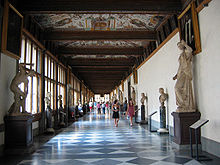
Florentine architects such as Filippo Brunelleschi (1377–1466) and Leon Battista Alberti (1404–1472) were among the fathers of Renaissance architecture.[86] The cathedral, topped by Brunelleschi's dome, dominates the Florentine skyline. The Florentines decided to start building it late in the 13th century, without a design for the dome. The project proposed by Brunelleschi in the 14th century was the largest ever built at the time, and the first major dome built in Europe since the two great domes of Roman times – the Pantheon in Rome, and Hagia Sophia in Constantinople. The dome of Santa Maria del Fiore remains the largest brick construction of its kind in the world.[87][88] In front of it is the medieval Baptistery. The two buildings incorporate in their decoration the transition from the Middle Ages to the Renaissance. In recent years, most of the important works of art from the two buildings – and from the nearby Giotto's Campanile, have been removed and replaced by copies. The originals are now housed in the Museo dell'Opera del Duomo, just to the east of the cathedral.
Florence has a large number of art-filled churches, such as

Artists associated with Florence range from Arnolfo di Cambio and Cimabue to Giotto, Nanni di Banco, and Paolo Uccello; through Lorenzo Ghiberti, and Donatello and Masaccio and the della Robbia family; through Fra Angelico and Sandro Botticelli and Piero della Francesca, and on to Leonardo da Vinci and Michelangelo. Others include Benvenuto Cellini, Andrea del Sarto, Benozzo Gozzoli, Domenico Ghirlandaio, Filippo Lippi, Bernardo Buontalenti, Orcagna, Antonio and Piero del Pollaiuolo, Filippino Lippi, Andrea del Verrocchio, Bronzino, Desiderio da Settignano, Michelozzo, Cosimo Rosselli, the Sangallos, and Pontormo. Artists from other regions who worked in Florence include Raphael, Andrea Pisano, Giambologna, Il Sodoma and Peter Paul Rubens.
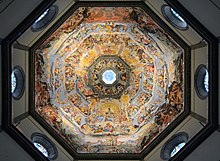
Picture galleries in Florence include the
Language
Florentine (fiorentino), spoken by inhabitants of Florence and its environs, is a
Although its vocabulary and pronunciation are largely identical to standard Italian, differences do exist. The Vocabolario del fiorentino contemporaneo (Dictionary of Modern Florentine) reveals
Dante, Petrarch, and Boccaccio pioneered the use of the vernacular[93] instead of the Latin used for most literary works at the time.
Literature

Despite Latin being the main language of the courts and the Church in the Middle Ages, writers such as Dante Alighieri[93] and many others used their own language, the Florentine vernacular descended from Latin, in composing their greatest works. The oldest literary pieces written in Florentine go as far back as the 13th century. Florence's literature fully blossomed in the 14th century, when not only Dante with his Divine Comedy (1306–1321) and Petrarch, but also poets such as Guido Cavalcanti and Lapo Gianni composed their most important works.[93] Dante's masterpiece is the Divine Comedy, which mainly deals with the poet himself taking an allegoric and moral tour of Hell, Purgatory and finally Heaven, during which he meets numerous mythological or real characters of his age or before. He is first guided by the Roman poet Virgil, whose non-Christian beliefs damned him to Hell. Later on he is joined by Beatrice, who guides him through Heaven.[93]
In the 14th century, Petrarch[94] and Giovanni Boccaccio[94] led the literary scene in Florence after Dante's death in 1321. Petrarch was an all-rounder writer, author and poet, but was particularly known for his Canzoniere, or the Book of Songs, where he conveyed his unremitting love for Laura.[94] His style of writing has since become known as Petrarchism.[94] Boccaccio was better known for his Decameron, a slightly grim story of Florence during the 1350s bubonic plague, known as the Black Death, when some people fled the ravaged city to an isolated country mansion, and spent their time there recounting stories and novellas taken from the medieval and contemporary tradition. All of this is written in a series of 100 distinct novellas.[94]
In the 16th century, during the Renaissance, Florence was the home town of political writer and philosopher Niccolò Machiavelli, whose ideas on how rulers should govern the land, detailed in The Prince, spread across European courts and enjoyed enduring popularity for centuries. These principles became known as Machiavellianism.
Music

Florence became a musical centre during the Middle Ages and music and the performing arts remain an important part of its culture. The growth of Northern Italian Cities in the 1500s likely contributed to its increased prominence. During the Renaissance, there were four kinds of musical patronage in the city with respect to both sacred and secular music: state, corporate, church, and private. It was here that the Florentine Camerata convened in the mid-16th century and experimented with setting tales of Greek mythology to music and staging the result—in other words, the first operas, setting the wheels in motion not just for the further development of the operatic form, but for later developments of separate "classical" forms such as the symphony and concerto. After the year 1600, Italian trends prevailed across Europe, by 1750 it was the primary musical language. The genre of the Madrigal, born in Italy, gained popularity in Britain and elsewhere. Several Italian cities were "larger on the musical map than their real-size for power suggested. Florence, was once such city which experienced a fantastic period in the early seventeenth Century of musico-theatrical innovation, including the beginning and flourishing of opera.[95]
Opera was invented in Florence in the late 16th century when
Cinema
Florence has been a setting for numerous works of fiction and movies, including the novels and associated films, such as
Video games
Florence has appeared as a location in video games such as Assassin's Creed II.[98] The Republic of Florence also appears as a playable nation in Paradox Interactive's grand strategy game Europa Universalis IV.
Other media
16th century Florence is the setting of the Japanese manga and anime series Arte.
Cuisine
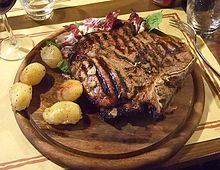
Florentine food grows out of a tradition of peasant fare rather than rarefied high cuisine. The majority of dishes are based on meat. The whole animal was traditionally eaten;
Among the desserts, schiacciata alla fiorentina, a white flatbread cake, is one of the most popular; it is a very soft cake, prepared with extremely simple ingredients, typical of Florentine cuisine, and is especially eaten at Carnival
Research activity
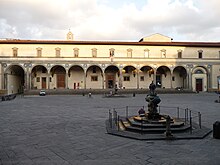
Research institutes and university departments are located within the Florence area and within two campuses at Polo di Novoli and Polo Scientifico di Sesto Fiorentino
Science and discovery
Florence has been an important scientific centre for centuries, notably during the Renaissance with scientists such as Leonardo da Vinci.
Florentines were one of the driving forces behind the Age of Discovery. Florentine bankers financed Henry the Navigator and the Portuguese explorers who pioneered the route around Africa to India and the Far East. It was a map drawn by the Florentine Paolo dal Pozzo Toscanelli, a student of Brunelleschi, that Christopher Columbus used to sell his "enterprise" to the Spanish monarchs, and which he used on his first voyage. Mercator's "Projection" is a refined version of Toscanelli's, taking the Americas into account.
Galileo and other scientists pioneered the study of optics, ballistics, astronomy, anatomy, and other scientific disciplines. Pico della Mirandola, Leonardo Bruni, Machiavelli, and many others laid the groundwork for modern scientific understanding.
Fashion

By the year 1300 Florence had become a centre of textile production in Europe. Many of the rich families in Renaissance Florence were major purchasers of locally produced fine clothing, and the specialists of fashion in the economy and culture of Florence during that period is often underestimated.
Historical evocations
Scoppio del Carro
The Scoppio del Carro ("Explosion of the Cart") is a celebration of the First Crusade. During the day of Easter, a cart, which the Florentines call the Brindellone and which is led by four white oxen, is taken to the Piazza del Duomo between the Baptistery of St. John the Baptist (Battistero di San Giovanni) and the Florence Cathedral (Santa Maria del Fiore). The cart is connected by a rope to the interior of the church. Near the cart there is a model of a dove, which, according to legend, is a symbol of good luck for the city: at the end of the Easter mass, the dove emerges from the nave of the Duomo and ignites the fireworks on the cart.
Calcio Storico

Calcio Storico Fiorentino ("Historic Florentine
Main sights
Florence is known as the "cradle of the Renaissance" (la culla del Rinascimento) for its monuments, churches, and buildings. The best-known site of Florence is the domed cathedral of the city,
The layout and structure of Florence in many ways harkens back to the Roman era, where it was designed as a garrison settlement.[11] Nevertheless, the majority of the city was built during the Renaissance.[11] Despite the strong presence of Renaissance architecture within the city, traces of medieval, Baroque, Neoclassical and modern architecture can be found. The Palazzo Vecchio as well as the Duomo, or the city's Cathedral, are the two buildings which dominate Florence's skyline.[11]
The river Arno, which cuts through the old part of the city, is as much a character in Florentine history as many of the people who lived there. Historically, the locals have had a love-hate relationship with the Arno – which alternated between nourishing the city with commerce, and destroying it by flood.
One of the bridges in particular stands out – the Ponte Vecchio ('Old Bridge'), whose most striking feature is the multitude of shops built upon its edges, held up by stilts. The bridge also carries Vasari's elevated corridor linking the Uffizi to the Medici residence (Palazzo Pitti). Although the original bridge was constructed by the Etruscans, the current bridge was rebuilt in the 14th century. It is the only bridge in the city to have survived World War II intact. It is the first example in the western world of a bridge built using segmental arches, that is, arches less than a semicircle, to reduce both span-to-rise ratio and the numbers of pillars to allow lesser encumbrance in the riverbed (being in this much more successful than the Roman Alconétar Bridge).
The church of San Lorenzo contains the Medici Chapels, a complex of burial chapels of the Medici family—the most powerful family in Florence from the 15th to the 18th centuries.
The Uffizi Gallery, one of the finest art museums in the world, was founded on a large bequest from the last member of the Medici family. It is located at the corner of
- In 1301, Dante Alighieri was sent into exile from here (commemorated by a plaque on one of the walls of the Uffizi).
- On 26 April 1478, Giuliano di Piero de' Mediciand wounding his brother Lorenzo. All the members of the plot who could be apprehended were seized by the Florentines and hanged from the windows of the palace.
- In 1497, it was the location of the Bonfire of the Vanities instigated by the Dominican friar and preacher Girolamo Savonarola
- On 23 May 1498, the same Savonarola and two followers were hanged and burnt at the stake. (A round plate in the ground marks the spot where he was hanged)
- In 1504, Michelangelo's David (now replaced by a replica, since the original was moved in 1873 to the Galleria dell'Accademia) was installed in front of the Palazzo della Signoria (also known as Palazzo Vecchio).
The Loggia dei Lanzi in Piazza della Signoria is the location of a number of statues by other sculptors such as Donatello, Giambologna, Bartolomeo Ammannati and Benvenuto Cellini, although some have been replaced with copies to preserve the originals.
-
Cattedrale di Santa Maria del Fiore
-
1835 City Map of Florence, still largely in the confines of its medieval city centre
-
Arno river
-
Florence at night from Piazzale Michelangelo
-
Ponte Santa Trinita with the Oltrarno district
-
The city of Florence as seen from the hill of Fiesole
-
Florence Duomo as seen from Michelangelo hill
Monuments, museums and religious buildings


Florence contains several palaces and buildings from various eras. The Palazzo Vecchio is the
Palazzo Medici Riccardi, designed by Michelozzo di Bartolomeo for Cosimo il Vecchio, of the Medici family, is another major edifice, and was built between 1445 and 1460. It was well known for its stone masonry that includes rustication and ashlar. Today it is the head office of the Metropolitan City of Florence and hosts museums and the Riccardiana Library. The Palazzo Strozzi, an example of civil architecture with its rusticated stone, was inspired by the Palazzo Medici, but with more harmonious proportions. Today the palace is used for international expositions like the annual antique show (founded as the Biennale dell'Antiquariato in 1959), fashion shows and other cultural and artistic events. Here also is the seat of the Istituto Nazionale del Rinascimento and the noted Gabinetto Vieusseux, with the library and reading room.
There are several other notable places, including the

Florence contains numerous museums and art galleries where some of the world's most important works of art are held. The city is one of the best preserved Renaissance centres of art and architecture in the world and has a high concentration of art, architecture and culture.[109] In the ranking list of the 15 most visited Italian art museums, ⅔ are represented by Florentine museums.[110] The Uffizi is one of these, having a very large collection of international and Florentine art. The gallery is articulated in many halls, catalogued by schools and chronological order. Engendered by the Medici family's artistic collections through the centuries, it houses works of art by various painters and artists. The Vasari Corridor is another gallery, built connecting the Palazzo Vecchio with the Pitti Palace passing by the Uffizi and over the Ponte Vecchio. The Galleria dell'Accademia houses a Michelangelo collection, including the David. It has a collection of Russian icons and works by various artists and painters. Other museums and galleries include the Bargello, which concentrates on sculpture works by artists including Donatello, Giambologna and Michelangelo; the Palazzo Pitti, containing part of the Medici family's former private collection. In addition to the Medici collection, the palace's galleries contain many Renaissance works, including several by Raphael and Titian, large collections of costumes, ceremonial carriages, silver, porcelain and a gallery of modern art dating from the 18th century. Adjoining the palace are the Boboli Gardens, elaborately landscaped and with numerous sculptures.

There are several different churches and religious buildings in Florence. The cathedral is
Florence contains various theatres and cinemas. The Odeon Cinema of the Palazzo dello Strozzino is one of the oldest cinemas in the city. Established from 1920 to 1922
Cathedral of Santa Maria del Fiore
Florence Cathedral, formally the Cattedrale di Santa Maria del Fiore, is the cathedral of Florence, Italy. It was begun in 1296 in the Gothic style to a design of Arnolfo di Cambio and was structurally completed by 1436, with the dome designed by Filippo Brunelleschi.
Squares, streets and parks

Aside from such monuments, Florence contains numerous major squares (piazze) and streets. The

Other squares include the Piazza San Marco, the Piazza Santa Maria Novella, the
Florence also contains various parks and gardens. Such include the Boboli Gardens, the
Sport

In association football, Florence is represented by ACF Fiorentina, which plays in Serie A, the top league of Italian league system. ACF Fiorentina has won two Italian Championships, in 1956 and 1969, and 6 Italian cups,[112] since their formation in 1926. They play their games at the Stadio Artemio Franchi, which holds 47,282. The women's team, ACF Fiorentina Femminile, have won the women's association football Italian Championship of the 2016–17 season.
The city is home of the Centro Tecnico Federale di Coverciano, in Coverciano, Florence, the main training ground of the Italian national team, and the technical department of the Italian Football Federation.
Florence was one of the host cities for cycling's 2013 UCI Road World Championships.[113][114] The city has also hosted stages of the Giro d'Italia, most recently in 2017.
Since 2017 Florence is also represented in Eccellenza, the top tier of rugby union league system in Italy, by I Medicei, which is a club established in 2015 by the merging of the senior squads of I Cavalieri (of Prato) and Firenze Rugby 1931. I Medicei won the Serie A Championship in 2016–17 and were promoted to Eccellenza for the 2017–18 season.
Rari Nantes Florentia is a successful water polo club based in Florence; both its male and female squads have won several Italian championships and the female squad has also European titles in their palmarès.
Transportation
Cars
The centre of Florence is closed to through-traffic, although buses, taxis and residents with appropriate permits are allowed in. This area is commonly referred to as the ZTL (Zona Traffico Limitato), which is divided into several subsections.[115] Residents of one section, therefore, will only be able to drive in their district and perhaps some surrounding ones. Cars without permits are allowed to enter after 7.30 pm, or before 7.30 am. The rules shift during the tourist-filled summers, putting more restrictions on where one can get in and out.[116]
Buses
ATAF&Li-nea was the bus company who run the principal public transit network in the city; it was one the companies of the consortium
Intercity bus transit is run by the
Since 1 November 2021, the public local transport is operated by Autolinee Toscane.[118]
Trams

In an effort to reduce air pollution and car traffic in the city, a multi-line tram network called Tramvia is under construction. The first line began operation on 14 February 2010 and connects Florence's primary intercity railway station (Santa Maria Novella) with the southwestern suburb of Scandicci. This line is 7.4 km (4+5⁄8 mi) long and has 14 stops. The construction of a second line began on 5 November 2011, construction was stopped due to contractors' difficulties and restarted in 2014 with the new line opening on 11 February 2019. This second line connects Florence's airport with the city centre. A third line (from Santa Maria Novella to the Careggi area, where the most important hospitals of Florence are located) is also under construction.[119][120][121][circular reference]
Florence public transport statistics
The average amount of time people spend commuting with public transit in Florence, for example to and from work, on a weekday is 59 min. 13% of public transit riders ride for more than 2 hours every day. The average amount of time people wait at a stop or station for public transit is 14 min, while 22% of riders wait for over 20 minutes on average every day. The average distance people usually ride in a single trip with public transit is 4.1 km (2.5 mi), while 3% travel for over 12 km (7.5 mi) in a single direction.[122]
Airport
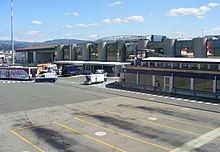
The
Mobike (bike-sharing)

Railway station
Parts of this article (those related to the status of high-speed rail to Florence) need to be updated. (November 2023) |
Train tickets must be validated before boarding. The main bus station is next to Santa Maria Novella
A new high-speed rail station is under construction and is contracted to be operational by 2015.[124] It is planned to be connected to Vespucci airport, Santa Maria Novella railway station, and to the city centre by the second line of Tramvia.[125] The architectural firms Foster + Partners and Lancietti Passaleva Giordo and Associates designed this new rail station.[126]
Education

The University of Florence was first founded in 1321, and was recognized by Pope Clement VI in 1349. In 2019, over 50,000 students were enrolled at the university. The European University Institute has been based in the suburb of Fiesole since 1976. Several American universities host a campus in Florence. Including New York University, Marist College, Pepperdine, Stanford, Florida State, Kent State, and James Madison. The Harvard University Center for Italian Renaissance Studies is based in Villa I Tatti. The center for arts and humanities advanced research has been located on the border of Florence, Fiesole and Settignano since 1961. Over 8,000 American students are enrolled for study in Florence, although mostly while studying in US based degree programs.[127]
The private school, Centro Machiavelli which teaches Italian language and culture to foreigners, is located in Piazza Santo Spirito in Florence.
Notable residents
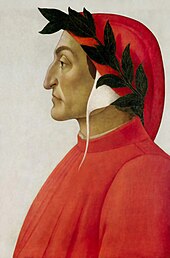



- Antonia of Florence, saint
- Agnes of Montepulciano, saint
- Harold Acton, author and aesthete
- John Argyropoulos, scholar
- Leone Battista Alberti, polymath
- Dante Alighieri (1265-1321), poet
- Giovanni Boccaccio, poet
- Cesare Bomboni, architect
- Sandro Botticelli (1445-1510), painter
- Egisto Bracci (1830–1909), architect
- Aureliano Brandolini, agronomist and development cooperation scholar
- Robert Browning and Elizabeth Barrett Browning, 19th-century English poets
- Filippo Brunelleschi (1377–1446), architect
- Michelangelo Buonarroti, sculptor, painter, author of the ceiling of the Sistine Chapel and David
- Francesco Casagrande, cyclist
- Roberto Cavalli, fashion designer
- Carlo Collodi, writer
- Enrico Coveri, fashion designer
- Donatello, sculptor
- Oriana Fallaci, journalist and author
- Salvatore Ferragamo, fashion designer and shoemaker
- Mike Francis(born Francesco Puccioni), singer and composer
- Silpa Bhirasri (born Corrado Feroci), sculptor, credited as the principal figure of modern art in Thailand[128]
- Frescobaldi family, notable bankers and wine producers
- Galileo Galilei, Italian physicist, astronomer, and philosopher
- Giotto (1267–1337), early 14th-century painter, sculptor and architect
- Lorenzo Ghiberti (1378–1455), sculptor
- Guccio Gucci (1881–1953), founder of the Gucci label
- Pauline von Hügel (1858–1901), baroness, writer, philanthropist
- Bruno Innocenti (1906–1986), sculptor
- Robert Lowell, poet
- Niccolò Machiavelli (1469-1527), poet, philosopher and political thinker, author of The Prince and The Discourses
- Masaccio, painter
- Rose McGowan, Florence-born actress
- Medici family
- Girolamo Mei, historian and humanist
- Antonio Meucci (1808-1889), inventor of the telephone
- cryptanalyst
- Florence Nightingale, pioneer of modern nursing, and statistician
- Virginia Oldoini(1837–1899), Countess of Castiglione, early photographic artist, secret agent and courtesan
- Valerio Profondavalle, Flemish painter
- Giulio Racah (1909–1965), Italian-Israeli mathematician and physicist; Acting President of the Hebrew University of Jerusalem
- Raphael, painter
- Anna Sarfatti (born 1950), children's author
- Girolamo Savonarola, reformist
- Adriana Seroni, politician
- Giovanni Spadolini (1925–1994), politician
- Antonio Squarcialupi (1416–1480), organist and composer
- Andrei Tarkovsky, film director. Lived in the city during his exile[129]
- Evangelista Torricelli, Italian physicist
- Anna Tonelli (c. 1763–1846), Florence born portrait painter in the late 17th century and early 18th century[130]
- Maria Giustina Turcotti (c. 1700 – after 1763), opera singer[131]
- Giorgio Vasari, painter, architect, and historian
- the Americas
- Coriolano Vighi, (1846-1905), landscape painter
- Leonardo da Vinci, polymath
- Lisa del Giocondo, model of the Mona Lisa
- Giorgio Antonucci, physician, psychoanalyst and an international reference on the questioning of the basis of psychiatry
International relations
Twin towns – sister cities
Florence is twinned with:[132]
- Bethlehem, Palestine
- Budapest, Hungary
- Dresden, Germany
- Edinburgh, Scotland, United Kingdom
- Fez, Morocco
- Isfahan, Iran
- Kassel, Germany
- Kyiv, Ukraine
- Kuwait City, Kuwait
- Kyoto, Japan
- Nanjing, China
- Nazareth, Israel
- Philadelphia, United States
- Puebla, Mexico
- Reims, France
- Riga, Latvia
- Salvador, Brazil
- Sydney, Australia
- Tirana, Albania
- Turku, Finland
- Valladolid, Spain
Other partnerships
Florence has friendly relations with:[132]
- Arequipa, Peru
- Cannes, France
- Gifu, Japan
- Jeonju, South Korea
- Kraków, Poland
- Malmö Municipality, Sweden
- Ningbo, China
- Porto-Vecchio, France
- Providence, Rhode Island, United States
- Tallinn, Estonia
See also
- Chancellor of Florence
- Cronaca fiorentina
- European University Institute
- List of historic states of Italy
- List of squares in Florence
- Category:Buildings and structures in Florence
Notes
- Latin: Florentia.
References
- ^ "Superficie di Comuni Province e Regioni italiane al 9 ottobre 2011". Italian National Institute of Statistics. Retrieved 16 March 2019.
- ISTAT. Select: Italia Centrale/Toscana/Firenze/Firenze.
- ISBN 1-85669-439-9
- ^ "Bilancio demografico mensile". demo.istat.it. Retrieved 25 April 2023.
- ^ "Economy of Renaissance Florence, Richard A. Goldthwaite, Book – Barnes & Noble". Search.barnesandnoble.com. 23 April 2009. Archived from the original on 4 April 2010. Retrieved 22 January 2010.
- ^ "Firenze-del-rinascimento: Documenti, foto e citazioni nell'Enciclopedia Treccani".
- ^ Spencer Baynes, L.L.D., and W. Robertson Smith, L.L.D., Encyclopædia Britannica. Akron, Ohio: The Werner Company, 1907: p. 675
- ^ "Florence | History, Geography, & Culture". Encyclopedia Britannica. Retrieved 3 November 2021.
- ISBN 0-520-04695-1.
- ^ "storia della lingua in 'Enciclopedia dell'Italiano'". Treccani.it. Retrieved 28 October 2017.
- ^ a b c d e f g h i j "Florence (Italy)". Britannica Concise Encyclopedia. Britannica.com. Retrieved 22 January 2010.
- ^ a b c "Fashion: Italy's Renaissance". Time. 4 February 1952. Archived from the original on 25 November 2010. Retrieved 9 October 2013.
- ^ Tim Kiladze (22 January 2010). "World's Most Beautiful Cities". Forbes. Retrieved 12 April 2011.
- ^ "Paris Towers Over World of Fashion as Top Global Fashion Capital for 2015". Languagemonitor.com. 6 July 2017. Retrieved 20 January 2016.
- ISBN 88-02-07228-0.
- ^ "History of Italian Language: From the Origins to the Present Day". Europass. Retrieved 19 June 2023.
- ^ Alighieri, Scuole d'italiano Dante (9 October 2018). "History of the Italian language: the literary language". Scuole d'italiano per stranieri Società Dante Alighieri. Archived from the original on 19 June 2023. Retrieved 19 June 2023.
- ^ johndeike (3 March 2021). "The Architects and Origins Behind the Italian Language". Italian Sons and Daughters of America. Retrieved 19 June 2023.
- ^ "History of Florence". Encyclopædia Britannica (Online ed.). Retrieved 9 February 2023.
- ISBN 0-14-016644-0.
- ISSN 0013-0613. Retrieved 16 October 2016.
- ^ defeated by Genoa in 1284 and subjugated by Florence in 1406
- JSTOR 40166507.
- S2CID 161168875.
- ^ "Decameron Web, Boccaccio, Plague". Brown University.
- ISBN 0-900658-15-0.
- ISBN 88-7624-659-2.
- ^ "Treccani - la cultura italiana | Treccani, il portale del sapere".
- ^ "History of Florence". Britannica.com. Retrieved 15 July 2021.
- ^ "Laurentian Library". michelangelo.net. Retrieved 15 July 2021.
- ^ Davis-Marks, Isis (2 June 2021). "Italian Art Restorers Used Bacteria to Clean Michelangelo Masterpieces". Smithsonian. Retrieved 15 July 2021.
- ^ Ryan, Billy (19 August 2020). "The Time When Jesus Was The King Of Florence". ucatholic.com. Retrieved 15 July 2021.
- ^ "July 3, 1944 newspaper archive". Canberra Times. 3 July 1944.
- ^ "Agosto 1944: la battaglia di Firenze « Storia di Firenze". www.storiadifirenze.org. Retrieved 22 February 2024.
- ^ "University Study Center, Florence « The GI University Project". Giuniversity.wordpress.com. 4 July 2010. Retrieved 16 November 2012.
- Turner, Joseph Mallord William (1819). "Fiesole from the River Mugnone outside of Florence". Tate. Retrieved 15 February 2020.
- .
Map showing the Arno river catchment and its major tributaries, the largest towns, and the sampling stations subdivided according to the sampling year. Coordinates refer to UTM32T (ED50) system.
- ^ "World map of Köppen – Geiger Climate Classification". koeppen-geiger.vu-wien.ac.at. April 2006. Retrieved 28 September 2010.
- ISBN 978-88-8251-382-5.
- ^ MeteoAM.it! Il portale Italiano della Meteorologia (20 May 2005). "MeteoAM.it! Il portale Italiano della Meteorologia". Meteoam.it. Archived from the original on 8 October 2006. Retrieved 22 January 2010.
- ^ "Valori climatici normali in Italia". Istituto Superiore per la Protezione e la Ricerca Ambientale. Archived from the original on 17 September 2023. Retrieved 17 September 2023.
- ^ "FIRENZE/PERETOLA" (PDF). Servizio Meteorologico. Retrieved 13 October 2012.
- ^ "World Weather Information Service - Florence". Retrieved 14 April 2010.
- ^ "Florence, Italy - Monthly weather forecast and Climate data". Weather Atlas. Retrieved 26 January 2019.
- ^ "Florence, Italy – Monthly weather forecast and Climate data". Weather Atlas. Retrieved 26 January 2019.
- ISBN 0-691-02910-5. Retrieved 27 October 2014.
- ISBN 978-90-04-18007-9. Retrieved 27 October 2014.
- ISBN 9781134636204. Retrieved 27 October 2014.
- ISBN 978-2-7605-2209-1. Retrieved 27 October 2014.
- ^ "Statistiche demografiche ISTAT". Demo.istat.it. Archived from the original on 26 April 2009. Retrieved 5 May 2009.
- ^ Chinese immigrants to Italy build no ordinary Chinatown, Chicago Tribune, 1 January 2009
- ^ "Statistiche demografiche ISTAT". Demo.istat.it. Archived from the original on 14 August 2013. Retrieved 5 May 2009.
- ^ "Archdiocese of Firenze {Florence}" Catholic-Hierarchy.org. David M. Cheney. Retrieved 7 October 2016.
- ^ "Metropolitan Archdiocese of Firenze" GCatholic.org. Gabriel Chow. Retrieved 7 October 2016.
- ^ Italy, The Local (7 April 2016). "Florence plans 'mega-mosque' for Muslim worshippers". The Local Italy. Retrieved 24 October 2023.
- ^ a b "Economy of Florence twice the national average – The Florentine". Theflorentine.net. 27 May 2016. Retrieved 28 October 2017.
- ^ "The world best cities are..." CNN. 16 October 2013. Retrieved 17 October 2013.
- ^ "La classifica dei redditi nei comuni capoluogo di provincia". Il Sole 24 ORE. Archived from the original on 12 May 2011. Retrieved 19 May 2010.
- ^ "Florence, Italy: Tourist Travel Guide for Holidays in Florence, Firenze, Italy". www.visitflorence.com. Retrieved 28 September 2015.
- ^ "Travel + Leisure". Travelandleisure.com. Retrieved 11 June 2011.
- ^ "15 Best Things to Do in Florence, Italy". Cntraveler.com. July 2016. Retrieved 28 October 2017.
- ^ Tourists spend more than ever before on cultural destinations Archived 9 February 2010 at the Wayback Machine (for 2004–2005) at Euromonitor International
- ^ "Study Abroad in Florence Italy – Florentine artisan courses for school groups". Florenceart.net. Archived from the original on 12 September 2009. Retrieved 22 January 2010.
- ^ "Florence's Uffizi leading the pack in terms of visitors' numbers, after the Colosseum and Pompeii". Florence’s Uffizi leading the pack in terms of visitors' numbers, after the Colosseum and Pompeii. Archived from the original on 29 October 2017. Retrieved 28 October 2017.
- ^ Poinelli, Ezio; Trakas, Themis; Brivio, Filippo (27 February 2017). "In Focus: Florence, Italy". HVS. Retrieved 2 July 2021.
- ^ [email protected], Bill Alen. "Florence: A Record Year for the Tourism Industry – .TR". Tourism-review.com. Retrieved 28 October 2017.
- ^ "Euromonitor International's Top City Destinations Ranking". Euromonitor.com. 2016. Retrieved 1 July 2017.
- ^ "Where in Europe are you Most Likely to be a Victim of Pickpocketing?". Yourcoffeebreak.co.uk. Retrieved 28 October 2017.
- ^ [email protected], Bill Alen. "Florence: A Record Year for the Tourism Industry – .TR". Tourism-review.com. Retrieved 28 October 2017.
- ^ "Italian hotspots struggling with 'too many tourists'". Thelocal.it. 18 July 2016. Retrieved 28 October 2017.
- ^ Kirchgaessner, Stephanie (6 December 2015). "Florence seeks a better class of tourist to share its besieged medieval treasures". The Guardian. Retrieved 28 October 2017.
- ^ Giuffrida, Angela (31 May 2017). "Florence mayor aims to keep picnicking tourists at bay with hosepipes". The Guardian. Retrieved 28 October 2017.
- ^ "Florence is hosing down monuments to deter tourists". Independent.co.uk. 1 June 2017. Retrieved 28 October 2017.
- ^ "Winners of the European Capitals of Smart Tourism 2022 competition". European Commission. Retrieved 7 November 2022.
- ^ Oxford Companion to Wine. "Bolgheri". Archived from the original on 8 August 2008.
- ^ ISBN 978-0-205-39392-3.
- ^ ISBN 978-0-495-91542-3.
- ^ a b c "The Power of the Past with Bill Moyers: Florence". 1990.
- ^ "Art in Florence". learner.org. Archived from the original on 25 October 2019. Retrieved 27 September 2010.
- ^ "Renaissance Artists". library.thinkquest.org. Archived from the original on 24 November 2010. Retrieved 28 September 2010.
- ^ "Uffizi Gallery Florence • Uffizi Museum • Ticket Reservation". Virtualuffizi.com. Archived from the original on 18 February 2009. Retrieved 5 May 2009.
- ISBN 5-85050-825-2
- ^ "Palace of Bargello (Bargello's Palace), Florence Italy". ItalyGuides.it. 28 October 2006. Retrieved 5 May 2009.
- ^ "Inner court of Pitti Palace (Palazzo Pitti), Florence Italy". ItalyGuides.it. 28 October 2006. Retrieved 5 May 2009.
- ^ "Auxologia: Graziella Magherini: La Sindrome di Stendhal (book)". Archived from the original on 12 October 2006. Retrieved 12 October 2006. (excerpts in Italian)
- ^ "Why Was Florence Considered Important For Culture And Arts? – Essay – Michellekim". StudyMode.com. Retrieved 14 March 2010.
- ^ "The Duomo of Florence | Tripleman". tripleman.com. Archived from the original on 6 December 2009. Retrieved 25 March 2010.
- ^ "brunelleschi's dome – Brunelleschi's Dome". Brunelleschisdome.com. Retrieved 25 March 2010.
- ^ "Florence, Tuscany Region, Italy – The Duomo, Statue of David, Piazza Dell Signoria". Europe.travelonline.com. Archived from the original on 13 July 2009. Retrieved 25 March 2010.
- ^ "Florence Art Gallery: Art Galleries and Museums in Florence Area, Italy". Florence.world-guides.com. Retrieved 25 March 2010.
- ^ "Become a friend of Palazzo Strozzi – Fondazione Palazzo Strozzi – Firenze". Palazzostrozzi.org. Archived from the original on 27 July 2011. Retrieved 25 March 2010.
- ^ "Vocabolario del fiorentino contemporaneo" [Dictionary of Contemporary Florentine] (in Italian). Accademia della Crusca. Retrieved 15 October 2019.
- ^ a b c d "Literature in Florence, Florentine Writers and Poets". Florenceholidays.com. Retrieved 25 March 2010.
- ^ a b c d e "Literature in Florence – Petrarch and Boccaccio, Florentine Writers and Poet: Petrarch and Boccaccio". Florenceholidays.com. Retrieved 25 March 2010.
- ^ a b .Hanning, Barbara Russano, J. Peter Burkholder, Donald Jay Grout, and Claude V. Palisca. Concise History of Western Music. New York: W.W. Norton, 2010.pg. 182.
- ^ Grout, Donald Jay, Donald Jay Grout, and Claude V. Palisca. A History of Western Music. New York: W.W. Norton & Company, 1973.
- ISBN 978-0-205-64531-2.
- ^ Ponce, Javier (1 May 2017). "Assassin's Creed II - The magic of the Renaissance in a video game". Bachtrack. Retrieved 20 August 2019.
- ^ welcometuscany.it. "Tuscany italy tuscany tourists guide, travel tips extra virgin olive oil wines and foods of the most beautiful land in the world". welcometuscany.it. Archived from the original on 15 May 2021. Retrieved 5 May 2009.
- ^ "Polo Scientifico di Sesto Fiorentino". Polosci.unifi.it. Archived from the original on 18 March 2014. Retrieved 18 March 2014.
- ^ "Florence CNR Research Area". Area.fi.cnr.it. Archived from the original on 7 August 2014. Retrieved 18 March 2014.
- ^ Frick, Carole Collier. Dressing Renaissance Florence: Families, Fortunes, and Fine Clothing. Baltimore: The Johns Hopkins University Press, 2002.
- ^ "The birth of italian fashion". Gbgiorgini.it. Archived from the original on 11 July 2018. Retrieved 7 May 2017.
- ^ "Conde Nast Traveller's guide to shopping in Florence". Cntraveller.com. 11 November 2009. Archived from the original on 8 September 2017. Retrieved 9 October 2013.
- ^ Calcio Storico Fiorentino (Official site) (in Italian)
- ^ Ross King, Brunelleschi's Dome, The Story of the great Cathedral of Florence, Penguin, 2001
- ^ Centre, UNESCO. "Historic Centre of Florence – UNESCO World Heritage Centre". whc.unesco.org. Retrieved 8 July 2015.
- ^ Travel in Tuscany. Gardens in Tuscany. Retrieved 25 August 2020.
- ^ Miner, Jennifer (2 September 2008). "Florence Art Tours, Florence Museums, Florence Architecture". Travelguide.affordabletours.com. Archived from the original on 29 January 2010. Retrieved 22 January 2010.
- ^ "Touring Club Italiano – Dossier Musei 2009" (PDF). Archived from the original (PDF) on 18 April 2012. Retrieved 12 April 2011.
- ^ "Gruppo Cine Hall". Cinehall.it. Retrieved 19 May 2010.
- ^ "FootballHistory.org". ACF Fiorentina. Martin Wahl. Retrieved 10 October 2019.
- ^ "UCI confirms 2013 WorldTour calendar". UCI. 20 September 2012. Retrieved 20 May 2021.
- ^ "General Information Bulletin" (PDF). UCI. Archived (PDF) from the original on 28 September 2013. Retrieved 20 May 2021.
- ^ "The ZTL – Avoid Restricted Traffic Zones & Fines in Italy – Italy Perfect Travel Blog". Italy Perfect Travel Blog. 16 June 2015. Retrieved 3 February 2018.
- ^ "Florence Driving Map, the ZTL explained : Florence on Line". www.florence-on-line.com. Retrieved 3 February 2018.
- ^ "Muoversi in Toscana". ONE Scarl. Retrieved 24 May 2022.
- ^ "Guida al primo giorno di servizio". Autolinee Toscane. Retrieved 30 May 2022.
- ^ "Arriva La Tramvia (in Italian)". GEST. Archived from the original on 8 October 2013. Retrieved 11 December 2011.
- ^ "Tramvia – Il Sistema Tramviario Fiorentino". Archived from the original on 2 February 2012. Retrieved 11 December 2011., Tramvia page of Florence's city government web site (in Italian).
- ^ Trams in Florence, Wikipedia article "Florence tramway"
- ^ "Firenze Public Transportation Statistics". Global Public Transit Index by Moovit. Retrieved 19 June 2017.
 Material was copied from this source, which is available under a Creative Commons Attribution 4.0 International License.
Material was copied from this source, which is available under a Creative Commons Attribution 4.0 International License.
- ^ "Grandi Stazioni – Firenze S. Maria Novella". Grandistazioni.it. Archived from the original on 9 May 2018. Retrieved 22 June 2009.
- ^ "Report Quindiciale N. 17" (PDF). Rete Ferroviaria Italiana. Archived from the original (PDF) on 9 May 2012. Retrieved 11 December 2011.
- ^ "Descrizione Della Linea 2" (PDF). Comune di Firenze. Archived from the original (PDF) on 9 May 2012. Retrieved 11 December 2011.
- ^ "Florence TAV Station". Foster + Partners. Archived from the original on 27 November 2011. Retrieved 11 December 2011.
- ^ "Association of American College and University Programs in Italy". Association of American College and University Programs in Italy. Retrieved 22 September 2019.
- ^ "Special Note : Professor Silpa Bhirasri's Life and Works". journal.su.ac.th. Archived from the original on 8 October 2011. Retrieved 27 October 2014.
- ^ Bilancio demografico anno 2013, dati ISTAT
- ^ Jeffares, Neil (2019). Dictionary of Pastellists Before 1800 (PDF) (online ed.). Archived (PDF) from the original on 4 March 2016.
- ISBN 1-56159-263-3.
- ^ a b "Gemellaggi e patti di amicizia" (in Italian). Florence. Retrieved 21 March 2022.
Sources
- Niccolò Machiavelli. Florentine Histories
- Brucker, Gene A. (1983). Renaissance Florence.
- Brucker, Gene A. (1971). The Society of Renaissance Florence: A Documentary Study. New York, Harper & Row. ISBN 0-06-131607-5.
- Chamberlin, Russell (22 May 2008). Travellers Florence & Tuscany, 3rd: Guides to Destinations Worldwide. Thomas Cook Publishing. ISBN 978-1-84157-844-6. Retrieved 11 March 2010.
- Chaney, Edward (2003), A Traveller's Companion to Florence.
- Goldthwaite, Richard A. (1982). The Building of Renaissance Florence: An Economic and Social History.
- Hibbert, Christopher (1999). The House of Medici: Its Rise and Fall.
- Lewis, R.W.B. (1996). The City of Florence: Historical Vistas and Personal Sightings. Farrar, Straus, and Giroux. ISBN 0-374-12404-3.
- Najemy, John (2006). A History of Florence 1200–1575.
- Schevill, Ferdinand (1936). History of Florence: From the Founding of the City Through the Renaissance. New York, Harcourt, Brace and Co.
- Trexler, Richard C. (1991). Public Life in Renaissance Florence.
- Ferdinand Schevill, History of Florence: From the Founding of the City Through the Renaissance (Frederick Ungar, 1936) is the standard overall history of Florence.
- Sciacca, Christine (2012). Florence at the Dawn of the Renaissance: Painting and Illumination, 1300–1500. Getty Publications. ISBN 978-1-60606-126-8. Archived from the originalon 20 September 2012. Retrieved 12 February 2016.

